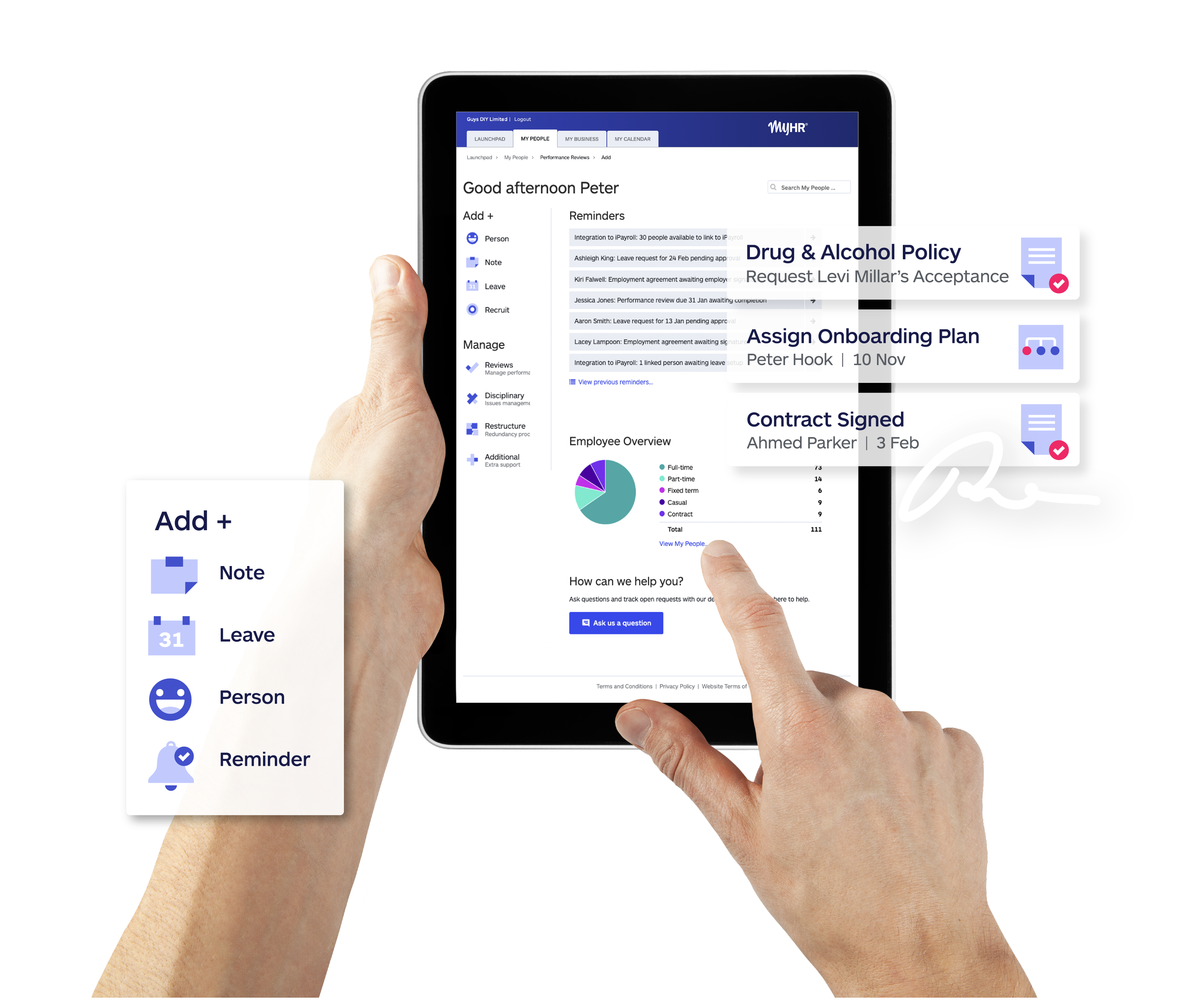Putting important company policies and procedures in writing makes good sense.
It compels you to think about how you want your workplace to run and the things you want to emphasise, and it makes these rules and guidelines official so you can show your employees what you expect from them and what they can expect from you.
Some businesses – especially small ones – can get by on verbal instructions and mutual understanding, but in the long-run, not having important company policies written down can lead to misunderstandings, disagreements, and mishaps.

There is a balance to be struck, however. Having a policy on absolutely every aspect of the business could be just as dangerous as having none at all, because you (or your managers) could get tripped up by not knowing about or not following all the rules.
Keep the policies simple. The aim is for everyone to understand and adopt them. They should provide useful information on responsibilities and rights in crucial areas, supporting but not duplicating or contradicting individual employment agreements.
At the end of the day, company policies should help protect your business while contributing to a safe and enjoyable work environment for everyone.
So rather than creating a burden of unnecessary paperwork and risky bureaucracy, here are 3 policies we recommend you have written down and stored somewhere they can be easily shared.
Develop a comprehensive health and safety policy
New Zealand has a pretty poor workplace health and safety record. In the past few years, changes to health and safety (H&S) regulations have sought to address this by shifting the focus from monitoring and recording incidents to proactively identifying and managing risks in the workplace.
By law, your business needs to ensure workers' health and safety and manage work risks ‘so far as is reasonably practicable’. You also need to make sure information about H&S is shared with workers, workers are engaged in H&S matters, and can contribute to workplace H&S decisions (this includes asking for employee input and providing ways for workers to participate in improving day-to-day health and safety in the workplace).
While there is no legal obligation to write down your risk-management efforts, having a written H&S policy will help ensure you have identified and managed all the risks. Every business and workplace is different, so thinking systematically will mean your health and safety efforts are tailored to the specific needs of your company.
The policy doesn’t need to be long but it should describe, in clear and simple terms, how your workplace will be kept safe and healthy and the procedures necessary to achieve it. The aim is to build an H&S culture that’s open and collaborative, so all your team members are involved and understand what they need to do.
Key clauses of a health & safety policy
- Purpose - introduction to the policy and why you have it (your aims).
- Scope - who the policy applies to.
- Overview and key concepts - explain important health and safety concepts in plain language.
- Details of the policy:
- The roles and responsibilities of the organisation (officially called the “Person Conducting a Business or Undertaking” or PCBU), managers/officers, and workers.
- Obligations of the PCBU, managers, workers, and other stakeholders.
- Worker engagement and participation procedures, e.g. if you have H&S representatives and/or a committee.
- Procedures for reporting incidents or emergencies.
- Appendices - include any information sheets, instruction documents (e.g. operating instructions) or forms, and where workers can get more resources (e.g. related reading).
Aside from keeping your workplace safe and ensuring you meet your legal responsibilities, having a H&S policy will increase productivity, reduce absenteeism, and give your workers, management, and customers confidence and peace of mind.
Read our article on why your business should have a H&S policy.
2. Workplace bullying and harassment
Part of keeping workers safe and healthy is making sure your workplace is free from intimidation and inappropriate behaviour.
Workplace bullying and harassment (including sexual harassment) is a serious issue in New Zealand - studies suggest that as many as one in three workers experience some form of bullying or harassment each year.
This is important. Bullying and harassment can create a risk to health and safety, affecting people physically and mentally, disrupting your workplace, reducing productivity, and exposing the business to personal grievance claims if behaviour goes unaddressed.
A bullying and harassment policy will help build a company culture where all people are respected. It helps set the example of what is acceptable in the workplace and clarifies the rights and obligations of employees and managers.
The policy should define the reporting process, and document how your business will handle issues and seek to resolve them. By law, bullying, harassment, and discrimination must be investigated and the person affected must be supported by the employer.
Make sure every employee is aware of the policy when they sign their employment agreement, and make sure it is a living document that is regularly reviewed. And like all workplace policies, if management isn't seen to support and model it, having it in writing will do more harm than good.
Find out more about bullying and harassment at Employment NZ.Employee code of conduct
Once you have the essential health and safety and workplace bullying & harassment policies covered, you can then develop a flexible code of conduct (you may want to call it a handbook or policy manual).
The code doesn't have to be complex, but should cover a range of general expectations for everyone in the business.
A good employee code of conduct document articulates the values the company wants to foster in leaders and team members, aligning standards of professional behaviour with the company's own values, principles, and mission.
While a code can't prevent inappropriate or illegal conduct, it should provide employees with a set of ethical guidelines to inform their decision-making and make it clear what the consequences of breaching these standards could be.
A code of conduct can be an important step in establishing an honest, inclusive culture, but simply requiring team members to read it isn’t enough. You should view it as part of an ongoing process that requires improvement, reinforcement, and training.
The scope of the code will be determined by the particulars of your business, but will usually cover the use of company assets and resources, protection of confidential information, avoiding conflicts of interest, and complying with laws and regulations.
Depending on your business type and industry, some of the key areas we recommend covering in your code of conduct are:
Customer service standards
Every business should have a basic expectation for employees to provide good customer or client service.
Having written standards will help define the level of service a customer can expect (e.g. receiving the correct order within 5 days) and remind management and employees what their obligations are when interacting with customers (e.g. treating customers with courtesy and respect).
IT and device use
Having a clearly written information technology (IT) usage policy is a good way to set ground rules for what staff can and can't do on and with technology in the workplace.
Your company could be held responsible for the actions of employees on your network, so having IT usage standards, (e.g. reasonable personal use of company devices, social media usage) can help minimise the risks and potential costs.
Similarly, if the company or its employees utilise artificial intelligence (AI) at work, it is important to set guidelines around its use to ensure you are not exposing yourself to legal, ethical, and operational risks.
Make sure you regularly review and update your policies. Technology is changing rapidly and the way we work changes with it, so you'll need to keep adapting to ensure your business data and IT systems are safe and secure.
Equal opportunities
Equal employment opportunities (EEO) is about creating a workplace that values diversity and enables all workers to contribute to their full potential.
While there is no legislation in New Zealand requiring private companies to implement EEO, it is unlawful to discriminate against an employee (or potential employee) on certain, specified grounds, e.g. gender, age, disability, sexual orientation, race, religion, political beliefs.
Putting equal opportunities in writing helps create a fair workplace environment and lets people know that basic human rights are non negotiable.
Expense claims management
If your people have some authority to spend company money in the course of doing their job, it is critical - both for tax and financial conduct purposes - to have clearly established rules and processes for managing expense claims.
Your expense claims policy should inform employees of their entitlements for reimbursement, any rates and conditions, and the process for claiming expenses.
A good expenses policy can simplify expense management, making it easier (and faster) for your finance team to assess and resolve expense claims, while improving employees’ compliance.
Getting started developing company policies
Not everyone is skilled at creating company policies or has time to tackle the task. It can take a lot of effort to boil down complicated concepts and procedures into policy documents that everyone on your team can easily understand and follow.
It starts with defining why you are creating the policy and who its audience is before you can do the scoping work on what it needs (or doesn’t need) to cover. Then comes the writing part.
Fortunately, the MyHR team is expert at creating important policies for organisations of any size and sector. We ensure all your employment documents are robust, in plain language, and always up to date with any changes to your business or legislation.
Our powerful HR platform means you and your staff can securely access your digital documents whenever and wherever you need to - no more filling out or editing paper forms - and you can easily set reminders for people to review and accept new versions.
If you’d like to explore how MyHR can help your organisation streamline its people management and employment processes, book a demo today.
-1.jpg)



